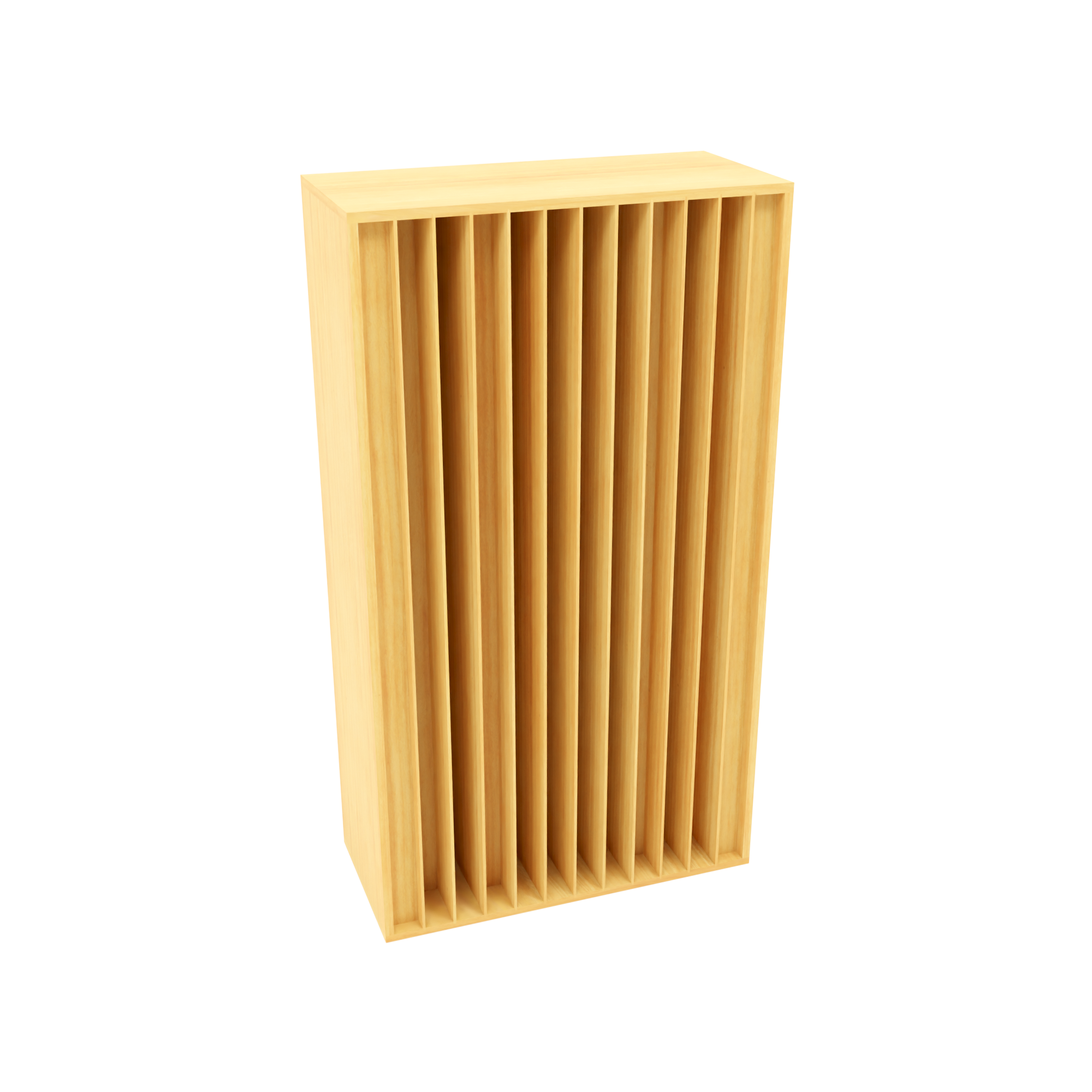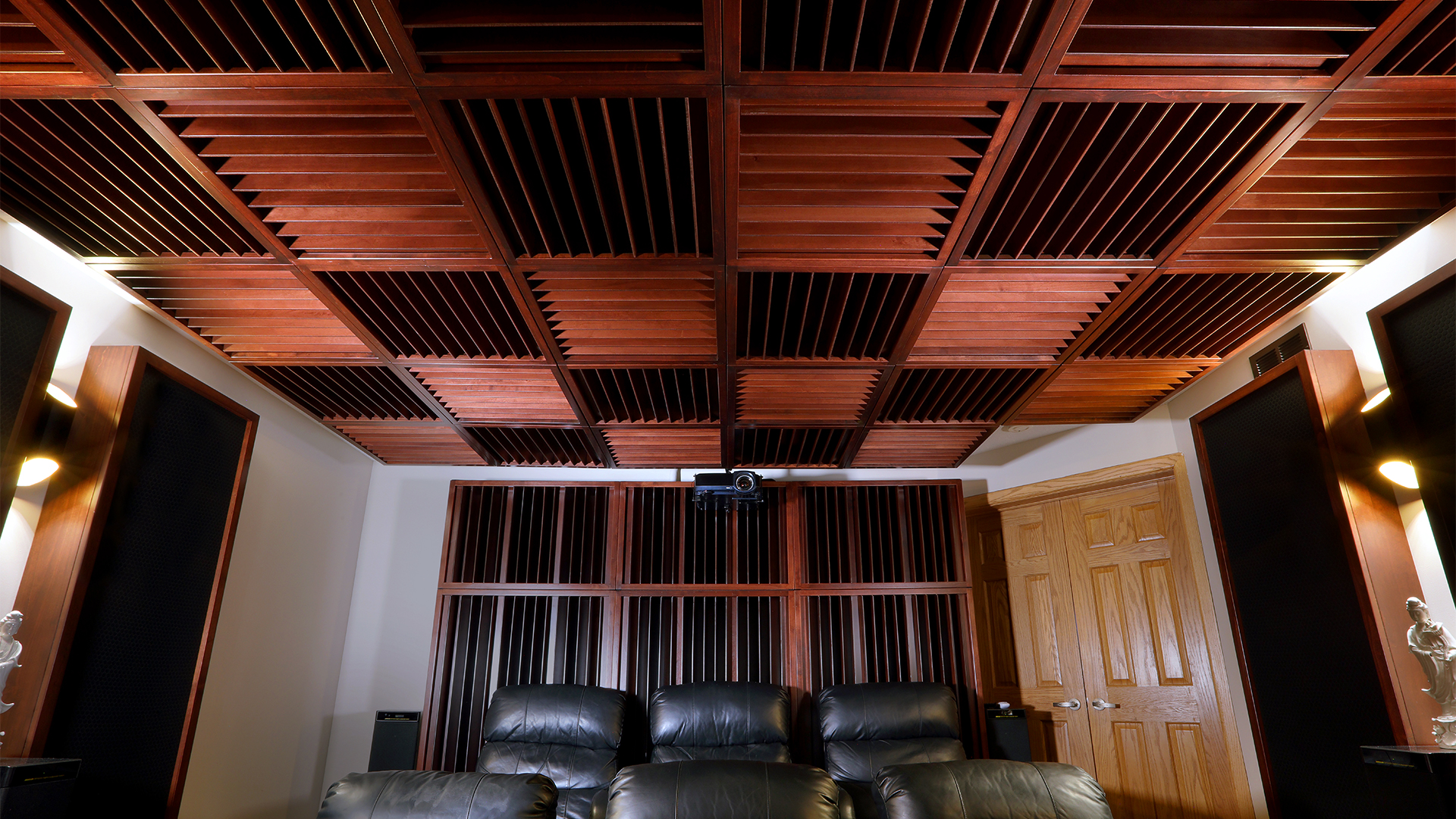A sound diffuser is a technology to reduce the impact of reflections from our walls and ceilings in our recording studios, home theaters, and any other critical listening environment. Reflections help our brains localize distance. The job of the diffuser and its sound diffuser pattern is to disrupt our brain’s ability to process the reflections and make our brains think that the surface area is farther away than it actually is. We have brought numerous people into our studio and blindfolded them before they enter the studio. We play a few songs for them and then ask them how far away the ceiling is. They always guess 12′ – 14′. Our studio ceiling height is 9′. This is the power of diffusion and its sound diffuser pattern it produces.
Sound Diffusion: https://en.wikipedia.org/wiki/Diffusion_(acoustics)
Quadratic DIffusion
Quadratic diffusion is the only true diffuser technology. Most other products are sound redirection devices with the name diffusion improperly applied. A quadratic diffuser is a series of wells or troughs that are of a certain depth and width. The well depth is calculated using quarter-wavelength rules. The well widths are calculated using half-wavelength rules. The frequency response or sound diffuser pattern created by these well depths and widths is calculated using a complex formula that is based upon prime numbers such as 7,11,13, 17, 19, and 23. Each prime number produces a series of well depths and widths that produce a low and high-frequency response. For example, a prime 13 diffuser has a maximum well depth of 12″ and a minimum well depth of 1″. The frequency response or sound diffusion pattern produced starts at 280 Hz. and goes through 3,450 Hz.
TAP: Type, Amount, Position
When choosing a quadratic diffuser for your room application, we must consider many variables. We must look at room usage. What you are doing within the room determines which surface areas you will need diffusion on and which areas we will need absorption. Remember there are only two treatment types that we can use. We have absorption and diffusion. If we have a home theater, we need diffusion on the ceiling and rear wall. If we have a control room, we need diffusion on the rear wall to reduce the time-delayed reflection from the rear wall so that the reflection time signature does not enter our mixes. If we have a two-channel listening room, we use diffusion on the front and rear walls. Diffusion is a technology to make the room sound larger.
Diffusion Set Up
All diffusers have a frequency response, just like a speaker. They have a lower-end frequency and a higher-end frequency. When we choose which diffuser to use for whatever our room usage is, we must take into consideration the room usage and the distances from the diffuser to the listening position. Since each diffuser has a low frequency and a high frequency at its minimums and maximum frequency range, we must allow enough distance from the diffuser to the listening position to make sure the lowest frequency since it is the longest to be able to fully form before it reaches the listening position. The sound diffuser pattern must have enough distance for the lowest frequency waveform to fully form along with each frequency or octave band covered by the frequency response of the diffuser. Let’s use our example of a prime number 13. The lowest frequency a prime 13 produces is 280 Hz. That energy wave has a wavelength of 4′. We must have a minimum distance of 6′ from the diffuser to the listening position for the waveform to fully form. It must be able to live and die on its own volition. We take the length of the lowest frequency waveform and add half of its length to produce the required distance for each prime number of diffusion.
One – Dimensional Diffusion
The sound diffuser pattern of quadratic diffusers is determined by the physical orientation of the diffusers. If you position a quadratic diffuser vertically you are producing a sound diffuser pattern of energy distribution that is a horizontal array of energy that is 180 degrees wide. If you position a quadratic diffuser that is horizontal, you will have a sound diffuser pattern that is a vertical 180 degree of energy. You can combine both horizontal and vertical diffusion on one surface area to produce two dimensions of diffusion which will distribute energy within a 360 degree of energy. To determine what type of diffusion to use within your room you must look at room usage and the distances from the diffusers to the listening position.
AF Diffusion Technologies: https://www.acousticfields.com/product-category/sound-diffusion/qd-series/
Two – Dimensional Diffusion
Alternating both vertical and horizontal diffusion produces an energy field that is covering a 360-degree array. two-dimensional diffusion has fewer distance requirements that one-dimensional diffusion. If you do not have enough distance for one-dimensional diffusion, you can use two-dimensional. It is less distance sensitive. Two-dimensional diffusion will make the surface area “disappear”. It will be difficult if you close your eyes to tell where the wall is. One-dimensional diffusion will add to image clarity and definition along with creating a wide sound field of energy distribution. Two-channel listening rooms benefit greatly from placing one-dimensional diffusion on the front and rear walls. This application produces a sound stage that is wide and has high resolution and definition.
No Compromise
Quadratic diffusion acts like a magnifying glass. It will highlight the good things you have done to your room but it will also exaggerate the issues within your room you have not treated correctly. You must have all low-frequency issues managed through the correct type, amount, and placement of the absorption technology. Low-frequency fundamentals are directly responsible for middle-range frequency harmonics. If you have frequency irregularities in your room frequency response curve, diffusion will make the issues more pronounced. If your reverberation times within the room are too high, diffusion will make your room sound worse. You must manage all issues within your room before applying diffusion to avoid the magnifying glass effect.
About Us At Acoustic Fields: https://www.acousticfields.com/about/










